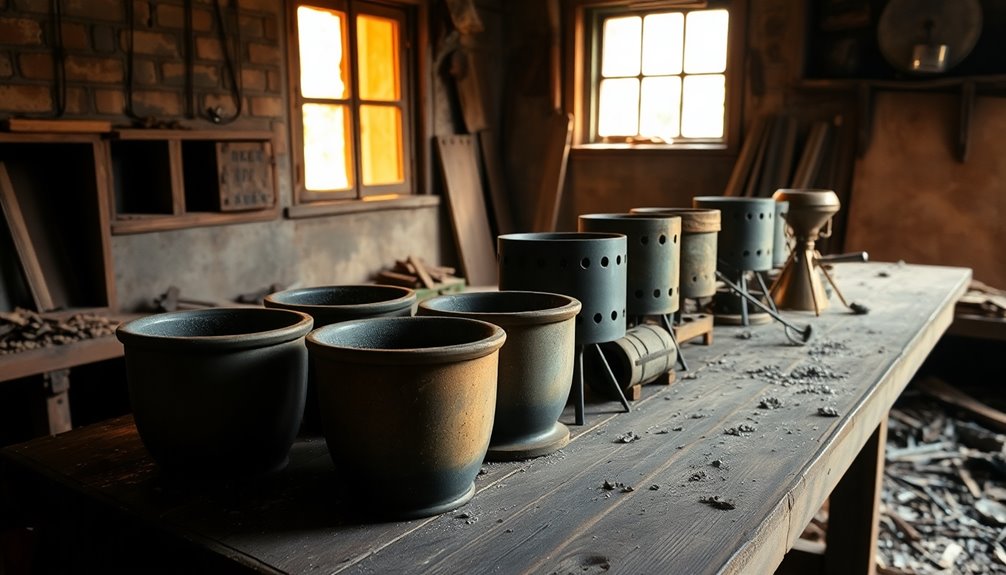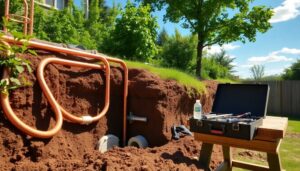To kick off your frugal DIY metal melting projects, choose the right crucible. Steel fire extinguishers make excellent, affordable options for melting aluminum. Be sure to check the type of steel with a magnet; it should stick. You can also repurpose stainless steel cups for smaller tasks. Create custom tools from scrap materials to enhance functionality. Always wear protective gear like heat-resistant gloves and goggles for safety. Regularly maintain your crucibles to guarantee they last. With a little creativity and the right techniques, you can achieve great results. Explore more tips that can boost your melting success!
Understanding Crucible Materials
When it comes to melting metals, understanding crucible materials is fundamental for successful projects. You'll want to make sure your crucible can withstand high temperatures, which means choosing the right materials is imperative.
Steel fire extinguishers can be a brand new option for creating cost-effective crucibles, provided you avoid aluminum, which just can't handle the heat. Conduct a magnet test on extinguishers to confirm they're made of steel; it's a pretty good way to make certain you're not wasting your time. Additionally, using expense management apps can help track your material costs and optimize your budget for these projects. The right expense tracking solution can lead to improved financial management and help you allocate funds effectively.
Another clever alternative is repurposing stainless steel cups from thrift stores. These can offer a tight fit for your metal, making them ideal for smaller projects.
Keep in mind that crucibles have a limited lifespan, so proactive maintenance is key. Regularly check for wear and tear to avoid failures during metal casting.
Proper heat management is also essential. Heating aluminum to a range of 1300-1400°F will help extend your crucible's life by preventing rapid damage. Additionally, using expense tracking tools can help you manage the costs associated with your metal melting projects efficiently.
Affordable Crucible Alternatives
Finding affordable crucible alternatives can greatly enhance your metal melting experience without breaking the bank. One nice option is to use steel fire extinguishers. These can serve as cost-effective crucibles, allowing you to melt metals efficiently. Additionally, using price comparison tools can help you find the best deals on materials needed for your projects. Remember that selecting the right tools can maximize investment growth in your metalworking hobby.
Just be sure to avoid aluminum extinguishers, as they've a lower melting point and won't hold up under high temperatures.
Another simple alternative is to visit thrift stores for stainless steel cups. They can be repurposed into effective crucibles, providing you with a budget-friendly solution.
You might also consider the "poor man's crucible" approach, which encourages resourcefulness in your metal casting hobby. This method makes it easier for you to experiment without investing heavily in specialized equipment.
However, it's important to remember that crucibles have a limited lifespan, so regularly replacing them before they fail is vital.
Always ascertain you're using steel materials and remove any non-steel components from extinguishers to maintain safety during your melting projects. Additionally, ensuring that you track performance metrics can help you identify the best alternatives for your specific melting needs.
Building Your Own Crucible
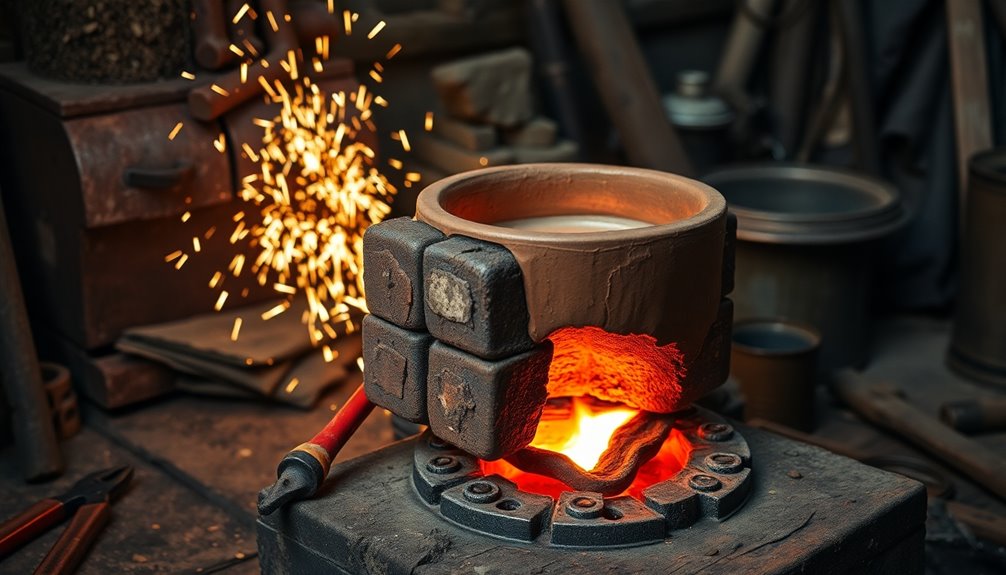
When you're building your own crucible, choosing the right materials is essential for successful metal melting. Consider factors like heat resistance and design to guarantee your crucible holds up under high temperatures. Additionally, selecting materials from sustainable retailers can contribute to a more environmentally friendly project. This aligns with the principles of sustainable fashion that emphasize the use of eco-friendly resources in various DIY endeavors. Don't forget to prioritize safety during assembly and maintain your crucible regularly to keep it in top shape. Additionally, utilizing sustainable materials can enhance the eco-friendliness of your DIY projects.
Material Selection for Crucibles
Choosing the right materials for your crucible is essential for successful metal melting. You'll want to make certain you select durable options that can withstand high temperatures.
Steel fire extinguishers are a fantastic choice; they're really nice for melting aluminum due to their durability. Just remember to perform a magnet test to confirm you've got a steel variant, as aluminum extinguishers won't cut it under heat.
If you're looking for something as simple as a budget-friendly alternative, consider using stainless steel cups from thrift stores. They work well for smaller projects, making them perfect for hobbyists who don't need large crucibles.
You can also enhance your crucible's functionality by modifying existing tools. Repurposing steel rods and utilizing "Frankenstein bolts" can improve handling during metal pouring.
Lastly, don't forget to regularly inspect and maintain your crucibles. Replace them before any signs of wear appear to guarantee safe and efficient metal melting.
DIY Crucible Construction Tips
Building your own essential container can be a rewarding and cost-effective way to enhance your metal melting projects. One option is to use steel fire extinguishers, which are often readily available and inexpensive. Just make sure to perform a magnet test to confirm they're steel.
If you're looking for a budget-friendly alternative, consider repurposing stainless steel cups from thrift stores; they can be a little bit of a treasure for hobbyists.
You can also modify scrap materials, like "Frankenstein bolts" and steel rods, to create custom tools that improve your DIY container setup. This not only saves you money but also gives you a unique setup tailored to your needs.
Heat management is vital, especially when melting aluminum. Be sure to soak it at temperatures between 1300-1400°F for best results while extending your container's lifespan.
Finally, regularly inspect and clean your containers before use. A little bit of maintenance can go a long way in ensuring safety and performance, so replace any worn-out containers proactively to avoid potential failures during metal pouring.
Safety Considerations During Assembly
How can you guarantee safety while assembling your own crucible? First and foremost, prioritize protective gear importance. Always wear gloves, goggles, and a face shield to shield yourself from potential injuries caused by tools and molten metal.
Crucible assembly precautions are essential; inspect and test your crucible for any signs of wear or damage before each use. This practice guarantees it's safe for melting operations.
Next, pay attention to your workspace safety practices. Keep your area clean and free from flammable materials to minimize fire hazards during construction and use.
If you need to modify tools or components, make sure you utilize durable materials and follow proper procedures to avoid accidents.
Finally, after finishing your project, dispose of any leftover materials and debris safely. This step not only maintains a safe working environment but also helps you adhere to local regulations.
By implementing these strategies, you can confidently assemble your own crucible while keeping safety at the forefront of your DIY metal melting projects.
Modifying Tools for Metalworking
When you modify your metalworking tools, using scrap materials can make a huge difference in their functionality. Simple enhancements, like adding "Frankenstein bolts," can improve handling and safety during your projects. Additionally, employing expense categorization for your metalworking projects can help track costs and ensure efficient budgeting. By using a budget app, you can monitor expenses related to your modifications and stay within your financial limits. This approach not only aids in tracking costs but also enhances financial well-being by promoting smarter spending habits.
Repurposing Scrap Materials
Repurposing scrap materials can breathe new life into your metalworking projects, making them both cost-effective and creative. You can find excellent scrap sourcing opportunities in discarded items like stainless steel cups and fire extinguishers, which serve as practical alternatives to traditional melting pots. By employing material creativity, you can transform these everyday objects into efficient melting vessels.
Consider using "Frankenstein bolts" to enhance your tools. These modifications can greatly improve usability during metal pouring, allowing for smoother operations. You might even craft custom tools from steel rods and tubes, showcasing the versatility of scrap materials for your specific needs.
Effective melting pot design is essential, so think about adjusting the pull pin from a fire extinguisher to improve heat management and extend your melting setup's lifespan.
Remember that regular inspection and testing of your modified tools is important to guarantee safety and reliability. By developing solid repurpose strategies, you not only save money but also embrace a more sustainable approach to metalworking.
Tool Handling Enhancements
Building on the creativity of repurposing scrap materials, modifying your tools can greatly improve your metalworking experience. By implementing tool efficiency upgrades, you can make your equipment more user-friendly and effective. For instance, using "Frankenstein bolts" can improve the usability and handling of your tools, making them easier to manipulate during melting and pouring.
Consider incorporating ergonomic tool design in your modifications. This means adapting the shape and grip of tools to fit comfortably in your hands, which will reduce fatigue during long sessions.
Custom tool modifications, like creating support rings for controlled pouring, can markedly enhance safety and precision.
Don't forget about proper heat management; maintaining temperatures between 1300-1400°F for aluminum can extend the lifespan of your crucibles and prevent rapid wear.
Always test and inspect your modified tools before use to guarantee safety and effectiveness. By taking the time to adjust and enhance your tools, you'll create a more enjoyable and secure environment for all your metal melting projects.
With these improvements, you'll not only boost your productivity but also elevate your craftsmanship.
Melting Techniques for Aluminum
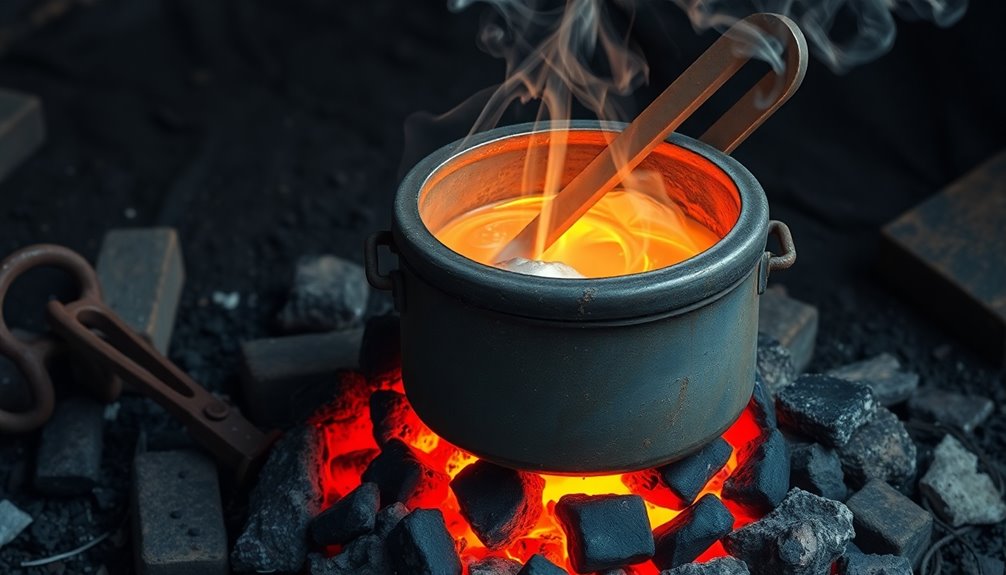
To effectively melt aluminum, it's vital to maintain your furnace temperature between 1300-1400°F. This range optimizes melting efficiency while also preserving the crucible lifespan. Utilizing timely payments for necessary supplies can help you stay within budget while engaging in your melting projects. Exclusive digital coupons can also aid in acquiring essential melting tools at a lower cost, ensuring you have the right equipment for your projects.
Soaking aluminum in heat for the right amount of time can yield the best results and minimize rapid crucible wear. You should apply soft heat gradually instead of jumping to high temperatures to avoid damaging your crucible.
Here are some key tips to enhance your melting process:
- Visualize the shimmering molten aluminum as it flows smoothly.
- Imagine the vibrant glow of the furnace radiating heat.
- Picture the sturdy crucible, holding its shape under high temperatures.
- Feel the satisfaction of watching aluminum oxide bubbles rise and pop.
- Envision your finished product, crafted from perfectly melted metal.
Regular inspection and maintenance of your crucibles before use are essential for guaranteeing safety and functionality, especially in preventing aluminum oxidation. Additionally, consider utilizing coupon codes for discounts on melting supplies to further enhance your DIY projects.
Safe Metal Pouring Practices
When pouring molten metal, you need to prioritize safety by wearing the right protective gear, like heat-resistant gloves and safety goggles.
Using controlled pouring techniques, such as a modified tool with a ring support, can help you manage the flow and reduce spills.
Plus, maintaining proper heat management by preheating your crucible guarantees efficiency and minimizes risks during the process.
Protective Gear Essentials
Safety should always come first in metal melting projects, and wearing the right protective gear is essential.
Not only does proper gear protect you from serious injuries, but it also helps you comply with safety regulations in your workspace.
Here's a list of must-have items for injury prevention:
- Heat-resistant gloves to shield your hands from burns while handling hot crucibles and molten metal.
- Face shield or safety goggles to guard your eyes against splashes and flying debris during the melting process.
- Steel-toed boots to protect your feet from heavy equipment and accidental spills of hot metal.
- Flame-resistant apron to cover your body from heat and molten metal during pouring.
- Fire extinguisher in your workspace for immediate response to emergencies.
Controlled Pouring Techniques
Mastering controlled pouring techniques is essential for guaranteeing safety and precision in metal melting projects. To achieve best results, you should consider using a modified tool equipped with a support ring. This enhances flow control, allowing for more accurate pouring angles and reducing the risk of accidents.
Before pouring, soak your aluminum in heat to guarantee a uniform melt, which will help with splash reduction and prevent uneven pouring.
Always inspect your equipment thoroughly to avoid failures during high-temperature operations. Using a sturdy, well-designed crucible can greatly extend its lifespan, providing you with a reliable tool for your projects. Remember to wear appropriate protective gear, as safety should always be your priority.
When you're ready to pour, keep the crucible steady and maintain a controlled angle to direct the molten metal precisely into your mold. This technique will minimize splashes and spills, making your metal casting experience safer and more efficient.
Heat Management Strategies
Effective heat management is essential for successful metal pouring practices, especially when working with aluminum. To achieve ideal melting, you'll need to maintain a furnace temperature between 1300-1400°F. This range not only guarantees efficient melting but also prolongs the lifespan of your crucible.
Here are some strategies to contemplate:
- Apply soft heat to reduce wear and tear on your crucibles.
- Soak aluminum in heat before pouring for complete liquefaction.
- Utilize temperature monitoring tools to keep an eye on the furnace's performance.
- Implement heat retention techniques to minimize energy consumption.
- Regularly inspect and test crucibles to catch any potential failures.
Selecting the Right Fire Extinguisher
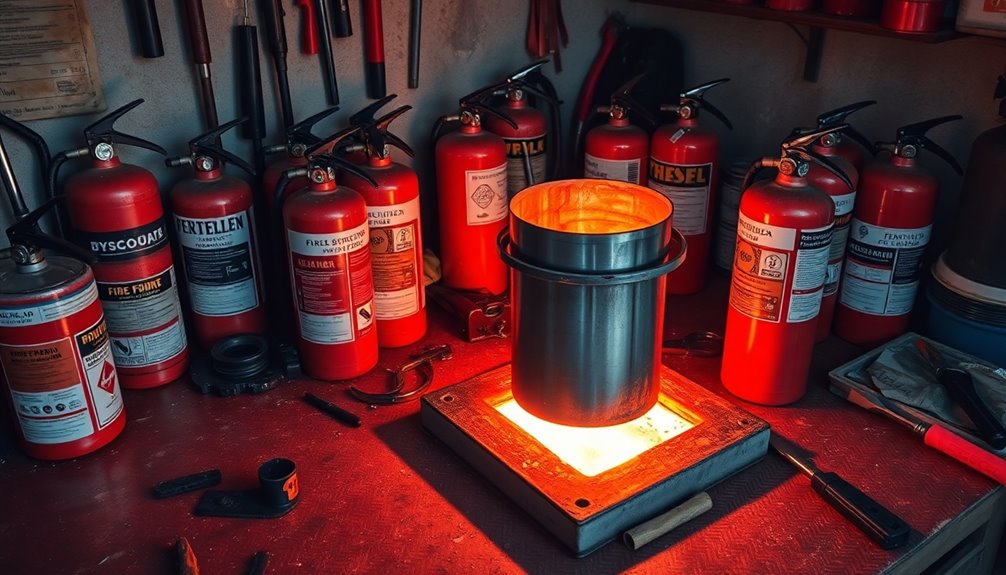
Choosing the right fire extinguisher is essential for anyone planning to melt metal, especially aluminum. When it comes to fire extinguisher types, prioritize steel models that can withstand higher temperatures.
Aluminum extinguishers won't cut it—they can melt and fail under the heat of your DIY metalworking tools.
To find a suitable steel extinguisher, conduct a magnet test. If the magnet sticks, it's likely steel and perfect for your melting projects. You can source these steel extinguishers from friends, local thrift stores, or online marketplaces, making them a budget-friendly option for DIY enthusiasts.
Before repurposing a fire extinguisher as a crucible, verify you remove any non-steel components, such as plastic handles or internal mechanisms. These parts can contaminate your aluminum during the melting process.
Finally, inspect and test the extinguisher's condition prior to use. Look for rust or damage, as these issues could compromise its integrity during high-temperature operations.
Preparing Fire Extinguishers for Use
When you're preparing fire extinguishers for use as crucibles, it's important to focus on steel models, as aluminum ones won't hold up under the intense heat needed for melting metals like aluminum.
Start with careful fire extinguisher selection to guarantee safety and efficiency.
Follow these steps to get your fire extinguisher ready:
- Conduct a magnet test; if it sticks, you've got steel.
- Remove all non-steel components like plastic parts or rubber seals.
- Cut off the valve mechanism to create a smooth opening for pouring.
- Inspect the extinguisher for any signs of wear or damage.
- Confirm to follow safety inspection protocols to prevent accidents.
Essential Safety Gear for Metalworking
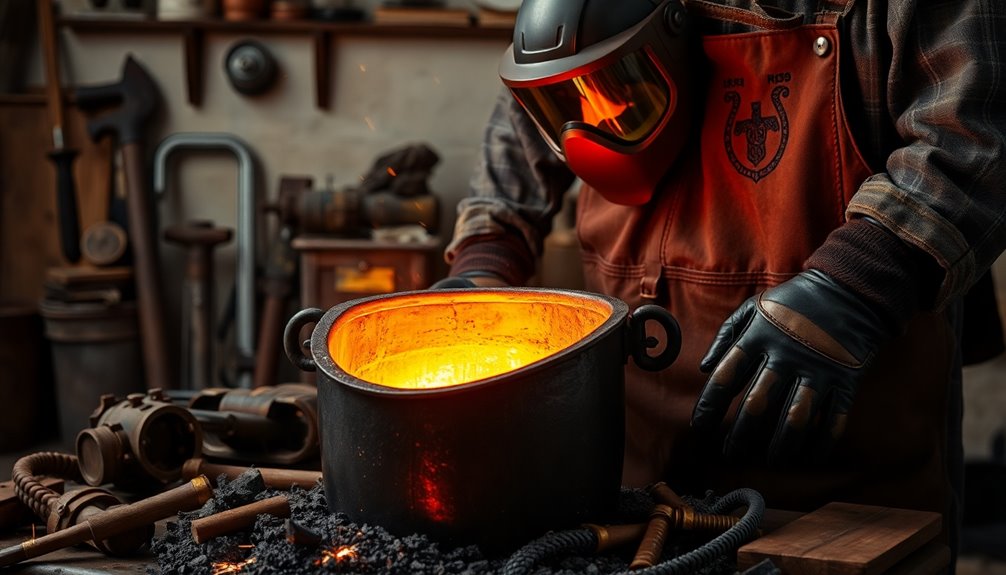
After confirming your fire extinguisher is ready for metal melting, it's time to focus on your safety gear.
First and foremost, invest in high-quality safety goggles, a significant advancement in eye protection. These goggles will shield your eyes from sparks and molten metal splashes, confirming your vision remains intact during your projects.
Heavy-duty leather gloves are another must-have. Recent gloves material improvements mean you can find options that provide both excellent grip and heat resistance, preventing burns when handling hot tools or materials.
Don't forget a flame-resistant apron or smock to protect your clothing and skin from heat and potential splatters while pouring molten metal. It's essential for maintaining a safe workspace.
Also, consider wearing steel-toed boots to safeguard your feet from heavy objects or accidental drops in your workshop.
Lastly, confirm your workspace is well-ventilated, and always use a properly fitted respirator to minimize exposure to harmful fumes created during metal melting.
Maintaining Your Crucible
Your crucible's longevity hinges on proper maintenance, making it imperative to clean it regularly after each use. Neglecting this can lead to residue buildup, decreasing melting efficiency and risking failures in future projects.
Here are some effective crucible cleaning techniques you should adopt:
- Use a stiff brush to remove any leftover metal or debris.
- Soak the crucible in a mild acid solution to dissolve stubborn residue.
- Rinse thoroughly with water to guarantee no cleaning agents remain.
- Dry completely before storing to prevent rust or oxidation.
- Check for any signs of wear, like cracks or warping, before each use.
Inspecting crucible integrity is essential. You should examine it for any damage that could compromise safety and performance.
Proper heat management, like maintaining temperatures between 1300-1400°F for aluminum, plays a key role in extending your crucible's lifespan. Remember, replacing crucibles after a limited number of melts is necessary, as their durability decreases over time.
Engaging With the Metalworking Community
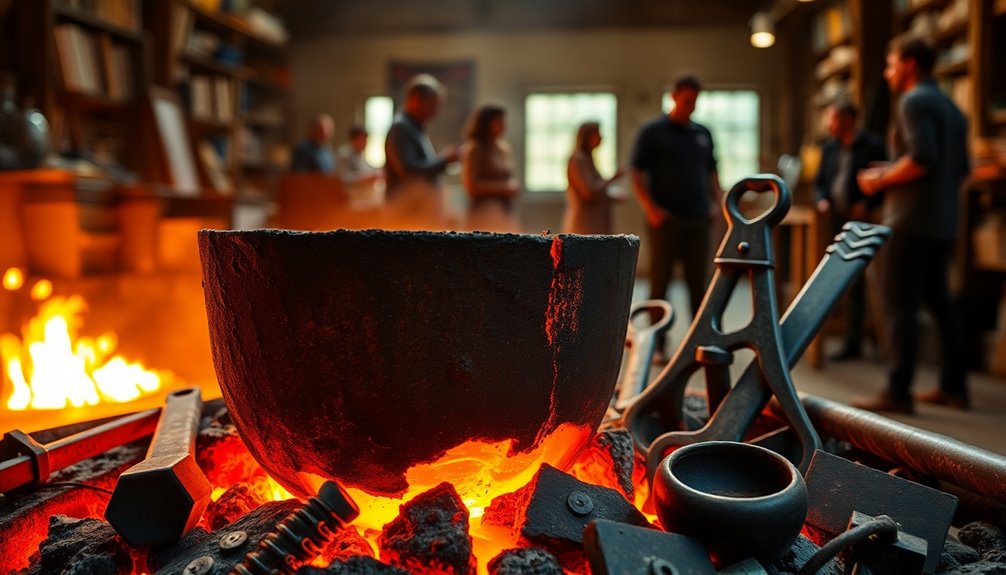
Proper maintenance of your crucible sets the stage for successful metal melting, but engaging with the metalworking community can further enhance your skills and knowledge.
By participating in community events and online forums, you can share experiences and discover innovative techniques that make your projects more efficient. These platforms foster a collaborative learning environment where both beginners and seasoned hobbyists come together.
You'll find that many enthusiasts are keen to share tips on cost-effective solutions, like using fire extinguishers and stainless steel cups as crucibles.
Don't hesitate to ask questions; the supportive nature of this network encourages knowledge sharing and fosters skill sharing.
Additionally, community resources often provide valuable guides on safety, maintenance, and tool modifications. Accessing this information can help you avoid common pitfalls in your DIY metal melting endeavors.
By connecting with others, you'll also learn about sourcing materials and optimizing crucible use for better melting efficiency.
Engaging with the metalworking community isn't just about gaining skills; it's about being part of a passionate group dedicated to innovation and improvement in metalworking techniques.
Sharing Tips and Experiences
In the world of DIY metal melting, sharing tips and experiences can greatly enhance your projects and skills. Engaging with others in the metalworking community not only broadens your knowledge but also fosters collaboration on exciting projects.
Here are some valuable insights to incorporate into your metal melting journey:
- Use modified fire extinguishers as crucibles—just remember to choose steel variants with a magnet test.
- Repurpose stainless steel cups from thrift stores for durable, cost-effective crucibles.
- Prioritize crucible maintenance by cleaning them after each use to prolong their lifespan and performance.
- Engage in community resource sharing through forums to gain insights from seasoned metalworkers.
- Innovate with scrap materials, like creating custom tools using "Frankenstein bolts" and steel rods for efficiency and safety.
Conclusion
Whether you're a seasoned metalworker or just starting out, melting metal at home can be both rewarding and cost-effective. You might think it's too complicated or expensive, but with the right knowledge and a little creativity, you can immerse yourself in DIY projects without breaking the bank. By embracing these frugal methods, you'll not only save money but also develop valuable skills. So grab your tools, connect with others, and start crafting your own metal creations today!

